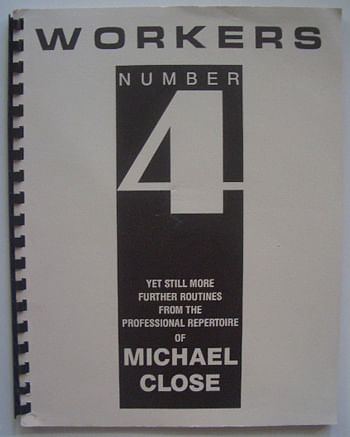Workers Number 4 by Michael Close
Reviewed by Jamy Ian Swiss (originally published in Genii September, 1994)

Michael Close is a singular magical stylist who brings a great deal of originality to his
presentations, technical competence to his handlings, and a uniquely quirky sense of
taste to his selection of material. His long-assured underground reputation as a highly
regarded innovator has become quite widespread since he stepped more visibly into the
light of magic publishing, lecturing, videos, contests and convention performances, a
step which largely began with his publishing Number One of the Workers series. Until
recently, Mr. Close was a resident performer who also supervised the roster of magicians
at Illusions, a family restaurant in Carmel, Indiana which features close-up magic at the
tables and bar, and essentially parlor magic in the lounge. I've had the pleasure of seeing
Mr. Close perform much of the material in the Workers collection, during my frequent
appearances at Illusions in the first 18 months of its existence.
Mr. Close is also an excellent writer, one who brings clarity and insight to his careful and
highly readable descriptions, notably assisted by his clever and often entertaining use of
subtitles as an organizing tool. Workers Number Four contains ten routines, which, as
Mr. Close writes in his introduction, "come from my current repertoire and are designed
to be performed under real life conditions." Four and a half of these routines are card
tricks, with the remainder utilizing common objects, and as in the three previous
volumes, one routine combines origami and conjuring. All of the material can be
performed close-up, however, at least two can easily be used in stand-up performances,
as Mr. Close does.
Simply put, there's not a bad trick in the book. As well, the material reflects a range of
style and technical requirements that increase the likelihood that there is something for
almost anyone in this collection. Amidst the non-card material, there is a version of the
classic coin transposition routine "Thieves and Sheep" using packets of sugar and the
popular low-calorie sweetener "Sweet 'n' Low," which relies upon a clever idea with
substantial potential for wider application.
While I disagree with some of Mr. Close's opening remarks about thread magic, he
provides one of the most practical applications I've seen of the recently popular "Super
Micro Invisible Thread Reel" to Gaetan Bloom's widely known (and occasionally stolen)
standing on edge card, and to a second lesser known but quite startling effect. Monsieur
Bloom is surely of our leading originators of effects relying upon invisible thread, and
Mr. Close's contribution makes these two wonderful effects more accessible than ever.
There is a brief but very fine idea for the vanish of an ordinary salt shaker, virtually from
the spectator's hands, and its recovery in a truly impossible location. "Ruthless
Peephole" is a trick which reveals Mr. Close's perverse and rather evil sense of humor, combining Dan Harlan's "Cardtoon" with an extremely clever idea of Karrel Fox's based
on the Cigarette Through Quarter which, like Mr. Close, I always liked but never found a
use for. Especially if you work behind a bar, and if you have an appreciation for the
darker sides of human nature, this is a diabolically hilarious bit of business.
The card material includes "Erma la Fource," which is Mr. Close's handling of the
"Oscar," or "Fred" trick, wherein the magician predicts any card freely named by a
spectator, using a deck of cards with a different common (or uncommon) name written
on the back of each card. This is a trick which has seen a great deal of variation both
above and beneath ground; Mr. Close's version, based on a handling of Harry Riser's, is
without a doubt the most deceptive one of which I am aware. Mr. Close considers the
stand-out item of the book to be his handling of, in turn, Tom Mullica's take on the
Johnny Paul/Jim Ryan routine for Cards Across. This plot is a true classic, of course,
and Mr. Close has made some interesting alterations in adapting the routine to his own
style, both in handling and presentation, along the way reducing the number of cards
transposed to two, instead of three. (Mr. Close was kind enough to perform this for me
at the 1993 World Magic Summit in Washington, DC, along with his exquisite "The
Card, the Forehead, and the Salt Shaker" from Workers Number Three. The latter is a
routine so extraordinary that, like any magic which relies upon that most sophisticated
yet often transparent of all conjuring skills, misdirection, you could lose a magic contest
with it.)
If I had to select a personal favorite from this volume it would be "Flying Home," an
extended routine for the card to pocket. Mr. Close makes a good case in the course of his
Cards Across routine for the importance of making material your own, and somehow
"Flying Home" appears to me to be as good if not an even better example. Mr. Close has
assembled a number of existing elements into an impressive sequence which, like the
Cards Across, is as magical and deceptive as it is funny and entertaining. Both routines
are features of Mr. Close's stand-up act.
As is typical of all of all of the Workers series, there is much valuable advice throughout
on timing, misdirection, technique, and presentation, because Mr. Close is kind enough
to provide full disclosure of all of these details of his work. This book is a bargain at the
price. I am somewhat disappointed that Mr. Close did not include some of his
thoughtful and extremely useful essays as he did in Workers Number Three (which
includes one of the finest discussions of palming to be found anywhere in the literature).
All four volumes are available from Mr. Close—collect the whole set.
